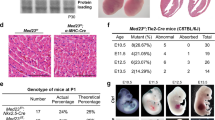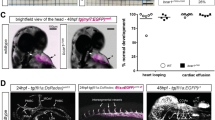Abstract
Integrity of the blood vessel wall is essential for vascular homeostasis and organ function1,2. A dynamic balance between endothelial cell survival and apoptosis contributes to this integrity during vascular development and pathological angiogenesis3,4,5,6. The genetic and molecular mechanisms regulating these processes in vivo are still largely unknown. Here, we show that Birc2 (also known as cIap1) is essential for maintaining endothelial cell survival and blood vessel homeostasis during vascular development. Using a forward-genetic approach, we identified a zebrafish null mutant for birc2, which shows severe hemorrhage and vascular regression due to endothelial cell integrity defects and apoptosis. Using genetic and molecular approaches, we show that Birc2 positively regulates the formation of the TNF receptor complex I in endothelial cells, thereby promoting NF-κB activation and maintaining vessel integrity and stabilization. In the absence of Birc2, a caspase-8–dependent apoptotic program takes place that leads to vessel regression. Our findings identify Birc2 and TNF signaling components as critical regulators of vascular integrity and endothelial cell survival, thereby providing an additional target pathway for the control of angiogenesis and blood vessel homeostasis during embryogenesis, regeneration and tumorigenesis.
This is a preview of subscription content, access via your institution
Access options
Subscribe to this journal
Receive 12 print issues and online access
$209.00 per year
only $17.42 per issue
Buy this article
- Purchase on Springer Link
- Instant access to full article PDF
Prices may be subject to local taxes which are calculated during checkout




Similar content being viewed by others
References
Red-Horse, K., Crawford, Y., Shojaei, F. & Ferrara, N. Endothelium-microenvironment interactions in the developing embryo and in the adult. Dev. Cell 12, 181–194 (2007).
Coultas, L., Chawengsaksophak, K. & Rossant, J. Endothelial cells and VEGF in vascular development. Nature 438, 937–945 (2005).
Winn, R.K. & Harlan, J.M. The role of endothelial cell apoptosis in inflammatory and immune diseases. J. Thromb. Haemost. 3, 1815–1824 (2005).
Carmeliet, P. Angiogenesis in life, disease and medicine. Nature 438, 932–936 (2005).
Duval, H., Harris, M., Li, J., Johnson, N. & Print, C. New insights into the function and regulation of endothelial cell apoptosis. Angiogenesis 6, 171–183 (2003).
Dimmeler, S. & Zeiher, A.M. Endothelial cell apoptosis in angiogenesis and vessel regression. Circ. Res. 87, 434–439 (2000).
Tricot, O. et al. Relation between endothelial cell apoptosis and blood flow direction in human atherosclerotic plaques. Circulation 101, 2450–2453 (2000).
Rajagopalan, S. et al. Endothelial cell apoptosis in systemic lupus erythematosus: a common pathway for abnormal vascular function and thrombosis propensity. Blood 103, 3677–3683 (2004).
Weinstein, B.M. Plumbing the mysteries of vascular development using the zebrafish. Semin. Cell Dev. Biol. 13, 515–522 (2002).
Jin, S.W. et al. A transgene-assisted genetic screen identifies essential regulators of vascular development in vertebrate embryos. Dev. Biol. 307, 29–42 (2007).
Deveraux, Q.L. & Reed, J.C. IAP family proteins–suppressors of apoptosis. Genes Dev. 13, 239–252 (1999).
Rothe, M., Pan, M.G., Henzel, W.J., Ayres, T.M. & Goeddel, D.V. The TNFR2-TRAF signaling complex contains two novel proteins related to baculoviral inhibitor of apoptosis proteins. Cell 83, 1243–1252 (1995).
Shu, H.B., Takeuchi, M. & Goeddel, D.V. The tumor necrosis factor receptor 2 signal transducers TRAF2 and c-IAP1 are components of the tumor necrosis factor receptor 1 signaling complex. Proc. Natl. Acad. Sci. USA 93, 13973–13978 (1996).
Ashkenazi, A. & Dixit, V.M. Death receptors: signaling and modulation. Science 281, 1305–1308 (1998).
Chen, G. & Goeddel, D.V. TNF-R1 signaling: a beautiful pathway. Science 296, 1634–1635 (2002).
Eimon, P.M. et al. Delineation of the cell-extrinsic apoptosis pathway in the zebrafish. Cell Death Differ. 13, 1619–1630 (2006).
Micheau, O. & Tschopp, J. Induction of TNF receptor I-mediated apoptosis via two sequential signaling complexes. Cell 114, 181–190 (2003).
Eckelman, B.P., Salvesen, G.S. & Scott, F.L. Human inhibitor of apoptosis proteins: why XIAP is the black sheep of the family. EMBO Rep. 7, 988–994 (2006).
Samuel, T. et al. Distinct BIR domains of cIAP1 mediate binding to and ubiquitination of tumor necrosis factor receptor-associated factor 2 and second mitochondrial activator of caspases. J. Biol. Chem. 281, 1080–1090 (2006).
Tang, E.D., Wang, C.Y., Xiong, Y. & Guan, K.L. A role for NF-kappaB essential modifier/IkappaB kinase-gamma (NEMO/IKKgamma) ubiquitination in the activation of the IkappaB kinase complex by tumor necrosis factor-alpha. J. Biol. Chem. 278, 37297–37305 (2003).
Sebban, H., Yamaoka, S. & Courtois, G. Posttranslational modifications of NEMO and its partners in NF-kappaB signaling. Trends Cell Biol. 16, 569–577 (2006).
Li, X., Yang, Y. & Ashwell, J.D. TNF-RII and c-IAP1 mediate ubiquitination and degradation of TRAF2. Nature 416, 345–347 (2002).
Irmler, M. et al. Inhibition of death receptor signals by cellular FLIP. Nature 388, 190–195 (1997).
Micheau, O., Lens, S., Gaide, O., Alevizopoulos, K. & Tschopp, J. NF-kappaB signals induce the expression of c-FLIP. Mol. Cell. Biol. 21, 5299–5305 (2001).
Eckelman, B.P. & Salvesen, G.S. The human anti-apoptotic proteins cIAP1 and cIAP2 bind but do not inhibit caspases. J. Biol. Chem. 281, 3254–3260 (2006).
Baud, V. & Karin, M. Signal transduction by tumor necrosis factor and its relatives. Trends Cell Biol. 11, 372–377 (2001).
Aggarwal, B.B. Signalling pathways of the TNF superfamily: a double-edged sword. Nat. Rev. Immunol. 3, 745–756 (2003).
Hayden, M.S. & Ghosh, S. Signaling to NF-kappaB. Genes Dev. 18, 2195–2224 (2004).
De Martin, R., Hoeth, M., Hofer-Warbinek, R. & Schmid, J.A. The transcription factor NF-kappa B and the regulation of vascular cell function. Arterioscler. Thromb. Vasc. Biol. 20, E83–E88 (2000).
Kisseleva, T. et al. NF-kappaB regulation of endothelial cell function during LPS-induced toxemia and cancer. J. Clin. Invest. 116, 2955–2963 (2006).
Acknowledgements
We would like to thank members of the Stainier laboratory for invaluable support and E. Kratz and P. Eimon for discussion and reagents. Support for this research came from a Human Frontier Science Program Fellowship (M.M.S.), Cardiovascular Research Institute National Institutes of Health Training Grant (T.M.) and grants from the US National Institutes of Health (AG-15402 (J.C.R.); HL-54737 (D.Y.R.S.)), American Heart Association and Packard Foundation (D.Y.R.S.).
Author information
Authors and Affiliations
Corresponding authors
Supplementary information
Supplementary Text and Figures
Supplementary Methods, Supplementary Figures 1–7 (PDF 3941 kb)
Rights and permissions
About this article
Cite this article
Santoro, M., Samuel, T., Mitchell, T. et al. Birc2 (cIap1) regulates endothelial cell integrity and blood vessel homeostasis. Nat Genet 39, 1397–1402 (2007). https://doi.org/10.1038/ng.2007.8
Received:
Accepted:
Published:
Issue Date:
DOI: https://doi.org/10.1038/ng.2007.8
This article is cited by
-
Identification of Potential Neddylation-related Key Genes in Ischemic Stroke based on Machine Learning Methods
Molecular Neurobiology (2024)
-
Endothelial cells require functional FLVCR1a during developmental and adult angiogenesis
Angiogenesis (2023)
-
Intracranial Aneurysms: Pathology, Genetics, and Molecular Mechanisms
NeuroMolecular Medicine (2019)
-
General anesthetics protects against cardiac arrest-induced brain injury by inhibiting calcium wave propagation in zebrafish
Molecular Brain (2017)
-
Ikk2 regulates cytokinesis during vertebrate development
Scientific Reports (2017)



